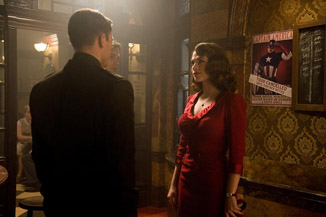(Comic) Book vs. Movie
Captain America
By Russ Bickerstaff
July 28, 2011
Eventually, Rogers runs into the scientist in charge of the super-soldier project. The process of turning him into Captain America is considerably more dramatic - involving several shots and the administration of “Vita Rays,” which only sound like they’re a ‘40s sci-fi concept. (They weren’t introduced into the origin until after the character’s resurrection in the ‘60s.) Duly satisfied that our hero isn’t some raving lunatic hiding behind a mask, the film proceeds to get Captain America involved in a series of events that make the character that much more believable. Why would the US government dress its prized success in some ridiculous costume? To become a symbol and sell war bonds, of course.
There are a number of characters introduced into the movie for various reasons - some of them from the silver age…a couple of them have made it more or less directly from the ‘40s. One of the two most important characters to have survived the 70-year period is Captain America’s sidekick Bucky. Here Bucky is re-envisioned as a man who was the Alpha male who knew Steve Rogers back before the program. They were both kids growing-up in Brooklyn. Now that Rogers is the Alpha male, things have changed, but there’s more of an equal footing between them that fits the modern buddy film image of two guys working together than the vaguely creepy man-boy thing that was so popular amongst heroes in the early days of super hero comics.
It’s kind of difficult to trace an exact idea as to where the origin for that early aesthetic came from. I’d like to think that it was the authors feeling that teenagers reading the comic book needed someone to more directly relate to the hero through. They were completely extraneous, of course, but the authors might have felt that it was necessary.
The arch-villain here is the Red Skull, but rather than being an American industrialist Nazi sympathizer, here he is a genuine German who was the first to take an earlier version of the super-soldier serum that makes Captain America who he is. This fits the desire to make Red Skull a full-fledged German villain. This has its origins in directions taken with the villain at the end of the Simon/Kirby issues in the ‘40s, but it wasn’t really fully fleshed-out until the resurrection of Captain America in the ‘60s. In the comic book, Red Skull was a man who had been trained by Hitler himself. The film envisions him as the first to experience the serum that made Captain America who he is/ As a result, it makes the two that much more equally opposed than previous incarnations.
The film quickly deviates from the comic books’ vision of the Red Skull as a Nazi, placing him at the head of an independent terrorist organization called HYDRA. And while this is expressly drawn from plot elements that developed in the ‘60s, the concept of a man wielding advanced technology with designs on a new world order bears quite a bit of resemblance to the Waxman story from the second issue of the original comic book series way back in 1941.
Continued:
1
2
3
4
5
6




